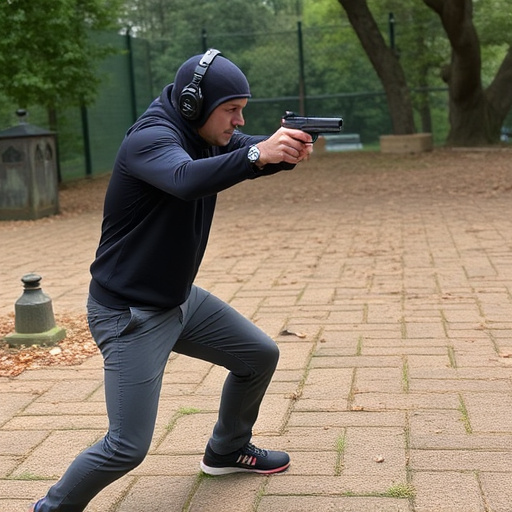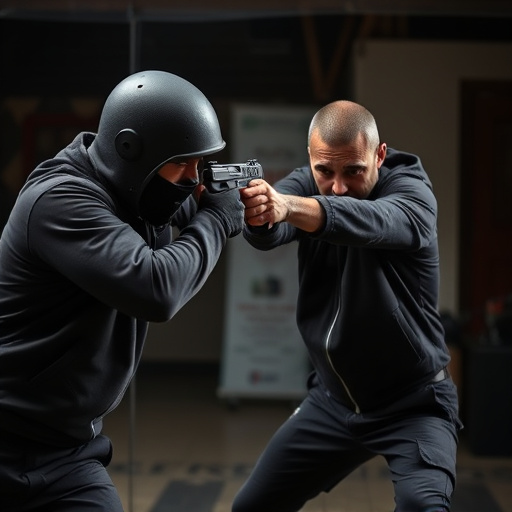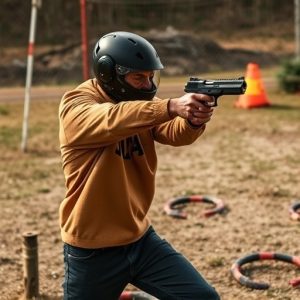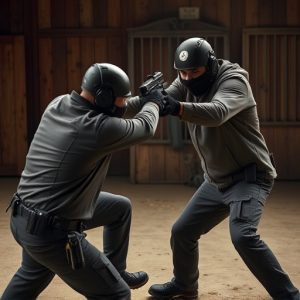Top 10 Stun Guns: Projectile vs Contact Weapons for Personal Protection
The article compares Projectile and Contact Stun Weapons for personal defense, emphasizing the impor…….
The article compares Projectile and Contact Stun Weapons for personal defense, emphasizing the importance of understanding their differences when choosing from the Top 10 stun guns. Projectile weapons like stun arrows offer safe distance via electric charges, while Contact weapons like tasers require physical contact to disrupt muscle control. Key features to consider include voltage output, charging time, safety features, and durability for daily carry. The Top 10 stun guns are characterized by high voltage, robust designs, and safety mechanisms, providing powerful yet controllable non-lethal force options based on personal preference and specific self-defense scenarios.
In the realm of self-defense, stun weapons offer a non-lethal option for individuals seeking protection. This article explores the critical distinction between projectile and contact stun devices, providing insights into their unique capabilities. We delve into the top 10 stun guns categorized by projectile types, highlighting their advantages. Additionally, we guide readers through the considerations when choosing a stun weapon, ensuring informed decisions for personal safety. Discover expert recommendations for effective self-defense with our comprehensive review of the best stun guns available on the market today.
- Understanding Projectile and Contact Stun Weapons: Key Differences
- Top 10 Stun Guns for Personal Protection: Projectile Types
- Advantages and Considerations of Contact Stun Devices
- Comprehensive Guide to Choosing the Right Self-Defense Stun Weapon
Understanding Projectile and Contact Stun Weapons: Key Differences

Projectile and contact stun weapons are two distinct categories within the realm of personal defense tools, each with unique characteristics and applications. When considering the top 10 stun guns for personal protection, understanding these differences is crucial. Projectile stun devices, such as stun arrows or shotguns with specialized rounds, operate by delivering a powerful impact at a distance, temporarily incapacitating the target with a high-voltage electric charge.
On the other hand, contact stun weapons, like stun batons or tasers, require physical contact to deploy their effect. They use electrical current to disrupt muscle control in the target’s body, causing temporary paralysis and disorientation. Both types have their advantages; projectiles offer a safe distance for deployment, while contact weapons are more versatile in close-quarters situations. Choosing between them depends on personal preference, potential threats, and specific self-defense scenarios.
Top 10 Stun Guns for Personal Protection: Projectile Types

When it comes to personal protection, stun guns offer a non-lethal option for self-defense. Among various types, projectile stun weapons stand out for their unique design and effectiveness. Here’s a look at the top 10 stun guns that utilize projectiles for personal safety:
1. Stun Gun Shotguns: These devices fire small rounds packed with a powerful electrical charge, covering a wider area compared to traditional stun guns. They are ideal for creating a distraction and disabling multiple attackers.
2. Taser-style Stun Guns: Inspired by Tasers, these weapons use two probes connected by wires to deliver an electric pulse. They provide a quick and reliable stun, making them popular choices for personal protection.
3. Laser Stun Guns: Emitting powerful laser beams, these tools can temporarily blind or disorient targets, offering a non-lethal but effective deterrent.
4. Projectile Stun Bats: Similar to baseball bats but equipped with electric pads, these stun batons provide both impact and electrical shock for self-defense in close quarters.
5. Stun Crossbows: Combining traditional crossbow design with modern electronics, these devices fire small bolts that deliver a powerful stun upon impact.
6. Airsoft Stun Guns: Utilizing compressed air or CO2 cartridges to fire plastic BBs, they offer both a visual shock and a slight physical sting for personal protection.
7. Stun Gun Darts: Small, handheld launchers that shoot darts laced with electrical current, providing an additional layer of safety when facing multiple threats.
8. Electric Staffs: Flexible yet sturdy staffs equipped with built-in stun technology, offering both balance and defense against potential assailants.
9. Stun Gun Flashlights: Combining the functionality of a flashlight with stun capabilities, these devices are versatile tools for navigating dark areas while deterring potential danger.
10. Micro Stun Guns: Compact and lightweight, these tiny weapons pack a punch, delivering powerful jolts in a discreet manner suitable for unexpected situations.
Advantages and Considerations of Contact Stun Devices

Contact stun devices, including stun batons and hand-held stun guns, offer several advantages when it comes to personal protection. Unlike projectiles, which can have limited range and accuracy, contact weapons ensure direct and immediate impact. This makes them ideal for close-quarters confrontations, as the user can quickly incapacitate an assailant with a well-placed strike. Stun devices are also known for their reliability; there’s no need to worry about ammunition or misfire, making them consistent choices for self-defense.
When considering a stun device for personal protection, it’s essential to look beyond the brand and model. Key features to consider include voltage output, which determines the level of shock delivered, and charging time. Top 10 stun guns for personal protection often boast high voltage ratings, ensuring maximum impact, but users should also be mindful of safety features to prevent accidental deployment. Durability is another critical factor, especially if you plan on carrying it daily; a robust design can withstand the rigors of constant use and different environments.
Comprehensive Guide to Choosing the Right Self-Defense Stun Weapon

When it comes to choosing a self-defense stun weapon, understanding the difference between projectile and contact options is key. Projectile weapons, such as stun guns or tasers, fire electrical charges or projectiles that disrupt an attacker’s muscular system, providing distance and time for escape. These are popular choices due to their ease of use, non-lethal nature, and effectiveness in neutralizing threats from a safe distance.
On the other hand, contact stun weapons, like batons or pepper spray wands, require direct contact with the assailant. They utilize kinetic energy or chemical irritants to cause pain, disorientation, or temporary blindness, making them ideal for close-quarters combat. When selecting the right self-defense tool, consider factors like ease of carry, power output, range, and your personal comfort level. The Top 10 stun guns for personal protection often top the list due to their high voltage, compact design, and advanced safety features, making them powerful yet controllable options for individuals prioritizing non-lethal force.
When it comes to self-defense, both projectile and contact stun weapons offer unique advantages. The Top 10 stun guns for personal protection, as highlighted in this article, provide a comprehensive guide to choosing the right tool based on individual needs. Understanding the key differences between these weapons—from their operating mechanisms to the level of force they exert—is essential. Contact stun devices excel in close-quarters situations, while projectile weapons offer a safe, non-lethal range option. Ultimately, selecting the ideal stun weapon depends on personal preferences, situational considerations, and the level of protection desired.


